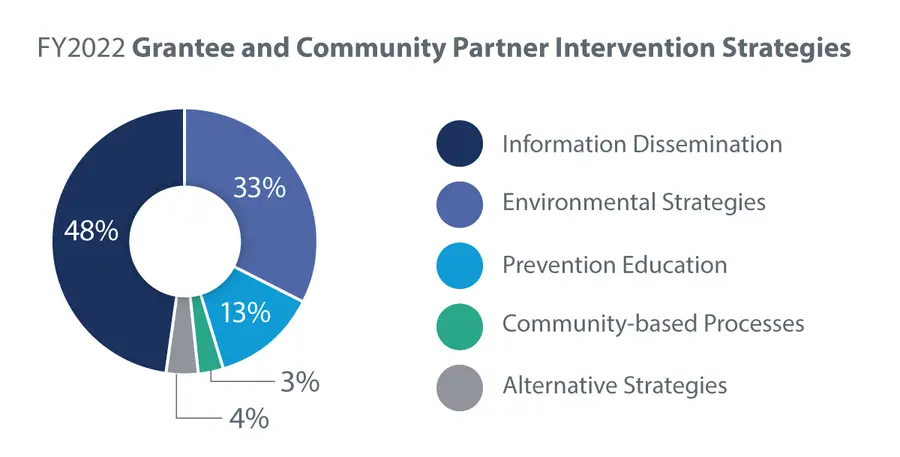Evaluating the Strategic Prevention Framework for Prescription Drugs Program
Objective
To evaluate the impact of the Strategic Prevention Framework for Prescription Drugs (SPF Rx) grantees in preventing and addressing prescription drug misuse in their states and tribal entities through the implementation of interventions.
Approach
Leveraging qualitative and quantitative data to measure implementation activities and document the accomplishments and challenges of grantees and their community partners.
Impact
In the first year of their grants, SPF Rx grantees and their community partners implemented 181 unique interventions that reached more than 14 million individuals. Eighty percent of the interventions implemented were information dissemination or environmental strategies.
Despite the emergence of fentanyl and other synthetic opioids over the past decade, prescription opioids continue to play a crucial role in the overdose crisis. Prescription opioid overdoses claimed 16,706 lives in the United States in 2021. Misuse of these drugs is widespread, with approximately 8.5 million individuals older than age 12 experiencing a prescription pain reliever use disorder in 2022. These individuals are our family members, friends, and coworkers; opioid use disorder impacts all of us.
In 2016, the Substance Abuse and Mental Health Services Administration (SAMHSA) launched the SPF Rx grant program to:
- Provide resources to help prevent and address prescription drug misuse across state, local, and tribal communities.
- Raise awareness about the dangers of sharing medication.
- Educate communities about the risks of fake or counterfeit pills purchased via social media or unknown sources.
- Work with pharmaceutical and medical communities to reduce overprescribing opioids.
The first cohort of 25 SPF Rx grants was awarded to 21 states and 4 tribal entities in 2016. This cohort received their SPF Rx grants for up to 5 years at approximately $370,000 each year. A second cohort of 21 SPF Rx grants was awarded to 18 states and 3 tribal entities in 2021. These grantees were awarded up to $500,000 per year for 5 years of prevention activities. SAMHSA encouraged both cohorts to engage community partners to implement interventions as part of the grant and magnify the impact of the funding.
RTI International is partnering with SAMHSA to evaluate the impact of the 2021 SPF Rx cohort through the Program Evaluation for Prevention Contract. As part of this partnership, RTI presented on lessons learned from the SPF Rx grantee cross-site evaluation alongside state and tribal grantees at SAMHSA’s 20th Prevention Day.
Successes from Year 1 of Grantee Implementation
In the first year of their grants, SPF Rx grantees and their community partners implemented 181 different interventions that reached or served more than 14 million individuals. The fiscal year (FY2022) interventions are categorized into five prevention strategy types by SAMHSA:
- Information Dissemination. Aim to increase knowledge and change attitudes through one-way communication (e.g., media campaigns, brochures).
- Environmental Strategies. Focus on the settings and conditions in which people live, work, and socialize. Examples include educating environmental influencers, such as prescribers; reducing access to substances through prescription drop boxes or safe storage; and implementing policies.
- Prevention Education. Use a two-way approach to teach participants important concepts and skills, such as resisting pressure to use drugs or looking at the intent behind advertising.
- Community-based Processes. Focus on strengthening resources—such as community coalitions—to increase the community’s ability to deliver effective prevention services.
- Alternative Strategies. Provide fun, challenging, structured, and alcohol- and drug-free activities that offer people constructive and healthy ways to enjoy free time and learn skills.
There is a sixth SAMHSA strategy type, problem identification and referral, which is focused on identifying users of illicit drugs or underage users of alcohol or tobacco and determining if behavior change is possible through education. No interventions in this strategy type were implemented by SPF Rx grantees in FY22.
Grantees and their community partners implemented various combinations of these strategies, but more than 80% of the interventions implemented in FY2022 used information dissemination or environmental strategies. About 40% of the involvements were classified by grantees or community partners as evidence based.

For their information dissemination interventions, grantees and their community partners used traditional media, digital media, hotlines, and more to enhance their target population’s knowledge about prescription drug misuse. In FY2022, SPF Rx communities interacted with more than 3.8 million prescription drug misuse prevention radio ads; 94,000 television ads; 84,000 brochures; 5,000 posters; and 1,000 print ads; along with several information hotlines, new websites, and social media posts.
Grantee and community partner environmental strategies included:
- Locating 46 new drug drop boxes in law enforcement agencies, pharmacies, and other locations.
- Conducting 21 training sessions to educate health care providers, dentists, pharmacists, law enforcement officers, and others about the dangers of prescription drug use.
- Implementing policy strategies on improved regulations for opioid prescribing and monitoring.
With all Implementation Comes Challenges
Nearly half of the SPF Rx 2021 cohort grantees reported at least one barrier to the implementation of a SPF Rx grant activity. Most barriers fell into one of four categories:
- Local perceptions of risk for opioid overdose and stigma toward opioid users. For example, communities tended to underestimate the risk of prescription medications or overestimate the risk of illicit drugs. As one grantee described it:
Some of the attitudes toward prescription drug misuse and abuse have been [declining], so people are not seeing it as much of a risk anymore. And so that is a negative impact in our community.
- Misalignment of state and grantee substance use prevention goals. One grantee described having difficulty implementing safe prescription dispensing education because its state’s goals primarily focused on illicit drug use. Another grantee noted that its state did not have legislation that allowed for harm reduction strategies; in turn, this grantee reported that stigma around harm reduction “[was] becoming… a hindrance when outreaching to new communities.”
- Prescription Drug Monitoring Programs (PDMPs) and data access challenges. States maintain PDMPs as electronic databases to track controlled substance prescriptions. However, some grantees cited legislation, lack of existing data collection systems, and staff turnover at the organization managing the PDMP as factors hindering data access. At the same time, several grantees reported efforts to improve PDMP data infrastructure by enhancing access to and use of PDMP data among states, grantees, and their community partners; improving the quality of data collected; and integrating electronic health records.
- Administrative challenges. Grantee-reported administrative challenges included state, tribal, or jurisdictional contract or other delays in getting community partners or high-need communities on board; staffing challenges; and funding challenges, including state budget cuts and delayed receipt of project funds.
But Implementation Improves with Partners
Grantees also provided insights on facilitators that helped with the implementation of SPF Rx activities. These facilitators primarily consisted of support from local- and state-level leadership and the partnerships grantees formed with other key individuals and organizations. For example, one grantee described how they effectively collaborated with their state leadership and partnered with other state agencies:
[SPF Rx has] allowed us a seat at the table to connect with our state, all the agencies involved with the state… in a way that we’ve never been able to do before… And it’s allowing this interconnected effort of like-minded, like-goaled entities.
How Early Successes Can Inform Future Implementation
SPF Rx 2021 cohort grantees’ and their partner communities’ successes and challenges contribute to four key lessons learned to guide current and future efforts to address the opioid crisis:
- Grantees can quickly implement a multicomponent prescription drug misuse prevention approach that includes community engagement. Nearly all grantees reported intervention implementation taking place within their states or tribal jurisdictions during the first year of their SPF Rx grant, and most engaged community partners to do so.
- Full implementation and evidence of impact of prescription drug prevention interventions take time. In the first year, many grantees and their community partners focused on easier-to-implement information dissemination interventions or continued interventions previously funded through other programs. Information dissemination activities play an important role in changing community norms and perceptions about the risk of misusing or sharing prescription opioids. However, only a few grantees and their community partners reported early implementation of potentially more directly effective academic detailing activities with health care providers. Based on grantee plans, those types of activities are expected to increase in future years.
- Grantees need support to address common and persistent barriers to their grant activities. This support could come from training and technical assistance providers and could also include a focus on fostering partnerships and gaining buy-in from state or tribal leadership. In addition, efforts to address the opioid crisis should benefit from continued national endeavors to provide accurate information on substance misuse–related risk and stigma, improved data resources, and support for the prevention workforce.
- Intervention efforts of grantees and their community partners benefit from forming key partnerships and gaining buy-in from state, jurisdiction, tribal, and community leadership. Grantees described partnerships and support from local and state-level leaders as important implementation facilitators for their SPF Rx efforts. Although grantees noted that building and strengthening partnerships was time-consuming, they also described these processes as necessary.
- Substance Abuse and Mental Health Services Administration (SAMHSA)
- Cloudburst Group
- EvalGroup




